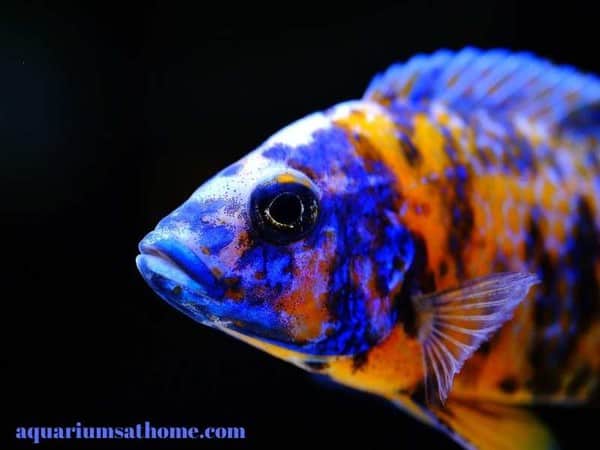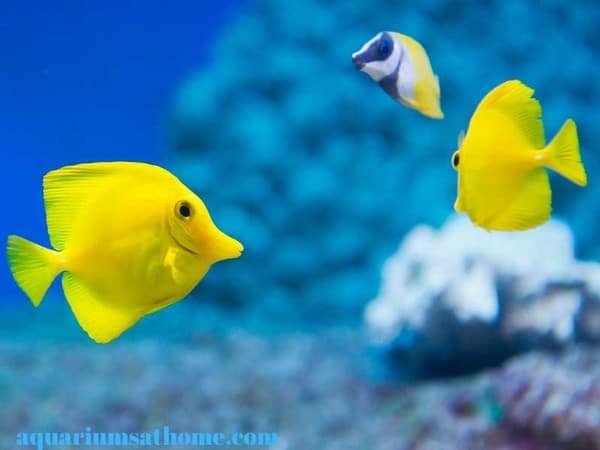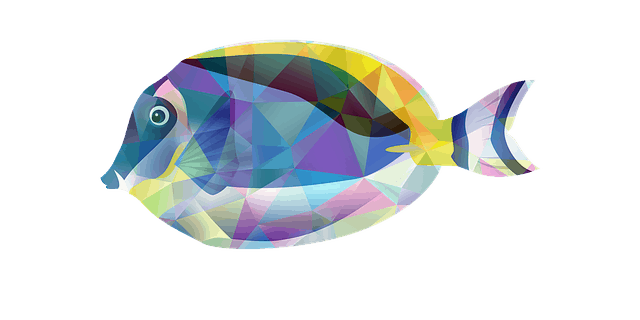As an aquarium hobbyist, there’s nothing better than observing a tank full of lively, vibrant fish. If you’re new to the hobby, you may be wondering why saltwater fish are often more colorful and attractive than freshwater fish? Well, I have the answer to that question…
The reason saltwater fish are more vibrant than their freshwater counterparts is the environment and the quality of the water in which they reside. Fish living in muddy, murky rivers and deep, dark lakes require different camouflage than those dwelling among brightly colored coral reefs.
Now that you know the aquatic environment plays a major roll in the physical appearance of fish, let’s dive deeper into this topic. As we move through this article together, I’ll explain what other factors affect fish coloring, what the most colorful saltwater and freshwater fish are, and what you can do to enhance the vibrancy of your aquarium fish.
So, if you’re ready to learn more about the colorful aquarium fish are why saltwater species (in general) are the most brilliantly hued, then let’s begin!
Why are Saltwater Fish Brighter?
Saltwater fish are usually more colorful than those living in freshwater environments. Since they often dwell in vibrant coral reefs, they need to be brilliant to blend-in with their surroundings and protect themselves from predations. Some saltwater fish can even see ultraviolet light! It’s likely that this ability can also transcend physically, allowing their bodies to display a brighter, wider range of colors.
Why are Freshwater Fish Less Colorful?
In most cases, freshwater fish tend to be less colorful than those found in the ocean or saltwater. Most species of freshwater fish are found naturally in muddy streams or deep lake waters where darkness abounds. These fish adapt to their surrounding by taking on these less-than-vibrant shades of black, brown, and blue to camouflage their appearance and avoid predatory attacks.
What are the Most Colorful Saltwater Fish?
Genetics, evolution, environment, and health all attribute to the vibrant palette of fish colors in the saltwater species most common among aquarium hobbyists. The most brilliant and bright examples include the following:
- clownfish
- fairy wrasses
- flame angels
- mandarin fish
- parrotfish
- triggerfish
- royal grammas
- seahorses
Since reef fish develop more color as a defense mechanism to blend in with their aquatic surroundings, they generally stand out more than freshwater fish in captivity. Feeding them a variety of nutrient-rich food, keeping their tank, and promoting a healthy social environment will all help maintain fish coloring.

What are the Most Colorful Freshwater Fish?
Just because saltwater fish tend to be more vibrant than freshwater fish, that doesn’t mean they don’t exist at all! There are species of freshwater fish that are just as bright and beautiful as their saltwater counterparts. These include the following:
- angelfish
- African cichlids
- bettas
- discus fish
- guppies
- gouramies
- killifish
- rainbow fish
In my opinion, discus fish are the most colorful of those listed above. They vary from solid shades of yellow and orange to deep patterned hues of iridescent blue and red. With so many color combinations, you’ll be hard-pressed not to find a few that peak your fancy!
Glofish are also a great choice for freshwater aquarium hobbyists who want to add a burst of color to their tanks. These fluorescent fish are the offspring of tetra or zebra fish that were at one time artificially enhanced. Now ‘born brilliant or naturally bright, they’re available in a multitude of shades including bright red, orange, yellow, green, blue, pink and purple.
What are the Drivers of Coloration in Marine Fish?
Chromatophores are the drivers of coloration in marine or saltwater fish. They produce colors by reflecting light using leucophores and iridophores. It’s the combination or overlapping of these two pigment-enhancing cells that creates the overall appearance. The primary purpose of chromatophores is to camouflage the fish by matching its brightness to that of the surrounding environment.
Do Bright Colors Scare Fish?
Bright colors may ward off ravenous attacks for (and from) certain species of fish. Hence why saltwater fish are often more vibrantly hued, living in the open ocean where predations abound. Since water absorbs different colors at varying depths, fish can see only specific shades depending on how deep they dwell, even though they see in full-spectrum light.
What Factors Affect Aquarium Fish Coloring?
There are 3 key components to coloration. These include brightness (the intensity of light), hue (mixture of wavelengths), and saturation (the purity of wavelengths). Apart from the environment, there other factors that affect aquarium fish coloring. Genetics, for one! Evolution and heredity will determine how a fish looks physically.
Health is yet another factor that affects fish coloring. When sick or stressed, fish can lose their vibrancy and appear dull, pale, or white. Most will even turn black when they die. Lack of sunlight, changes in water quality, and nutrient deficiency will also contribute fish coloring. Fish bred in captivity will also look different than others of their species that are wild caught.
How to Enhance Aquarium Fish Coloring?
There are number of ways to enhance aquarium fish coloring (both naturally and artificially). These include the following:
Keeping the Tank Clean
Exceptional water quality is the key to fish health. A healthy fish is a brilliant, beautiful fish which is why it’s so important to maintain a safe, toxic-free aquatic environment. Adding an effective filtration system and treating the water with conditioner to remove chlorine and neutralize ammonia are recommended.
And don’t forget to do weekly partial water changes as well. Testing the water parameters regularly is especially important. The proper temperature, pH, salinity, etc. are vital to the overall well-being and longevity of your aquarium fish.
Providing a Nutrient-Fish Diet
Feeding your fish high-quality food that’s rich in essential vitamins and minerals is very important. Not only will it keep them healthy and active, but it’ll also promote vibrancy. Spirulina or blue-green algae is excellent at bringing out fish coloring.
In fact, different colors of algae are known to enhance contrasting hues in many species of aquarium fish. Bloodworms and brine shrimp will encourage physical brilliance. Adding vitamin supplements or color-enhancing fish flakes to your aquatic pets’ diet will also help.
Encouraging a Safe Social Environment
Social stimulation is important for many species of aquarium fish. For shoaling fish, it keeps stress levels and bay and helps prevent bullying by others. Finding compatible tankmates is necessary to overall the health of your aquarium habitants so be sure to do your research and choose carefully.
Adding LED Lighting
Exposure to light is a necessary component in vibrant fish coloring. LED or multi-spectrum lighting is a great addition to any aquarium and helps to enhance fish hues by creating a shimmering effect in the water. You can even customize the color scheme by dimming certain shades and brightening others.
*Apart from diet, lighting, and water conditions, how you decorate your aquarium can also affect fish coloration. Setting up the tank to mimic their natural habitat as closely as possible has a significant impact on their well-being. This, in turn, impacts their physical appearance. Adding plants, rocks, substrate, backdrops, etc. in contrasting colors will also help make fish hues pop!

Conclusion
To conclude, environment is the most likely reason why saltwater fish are more colorful than those found in freshwater. Fish living in muddy streams or murky rivers are more likely to take on the same deep, dark appearance as a means of camouflage or protection. Other contributing factors include genetics, health, and exposure to ultraviolet light.
I hope this article has been both interesting and informative. Thanks for reading and good luck with your aquarium hobby.
Related Posts
How to Enhance Fish Color [In your Aquarium]
Best aquarium lighting for fish color [it’s easier than you think]
How to Bring Out Color in Cichlids
Are Blue Tangs Difficult to Keep?




